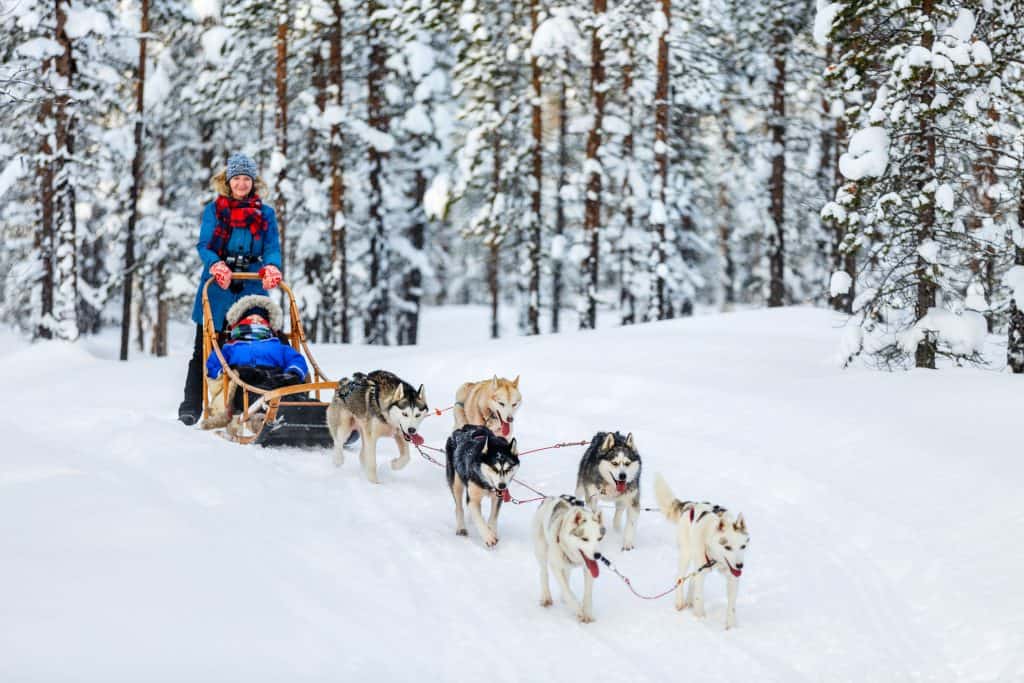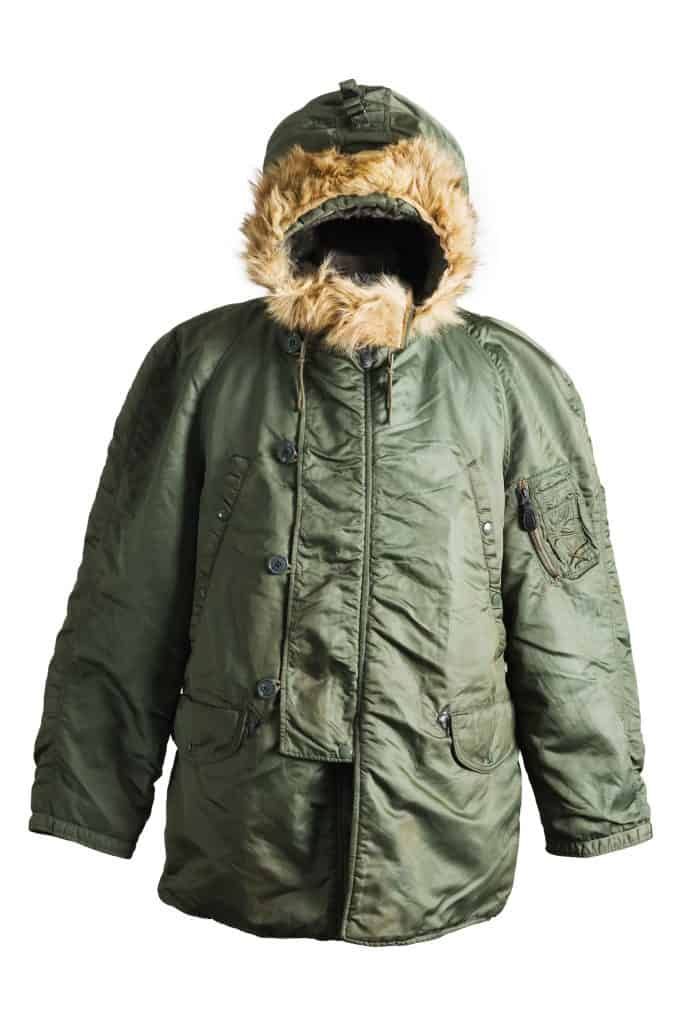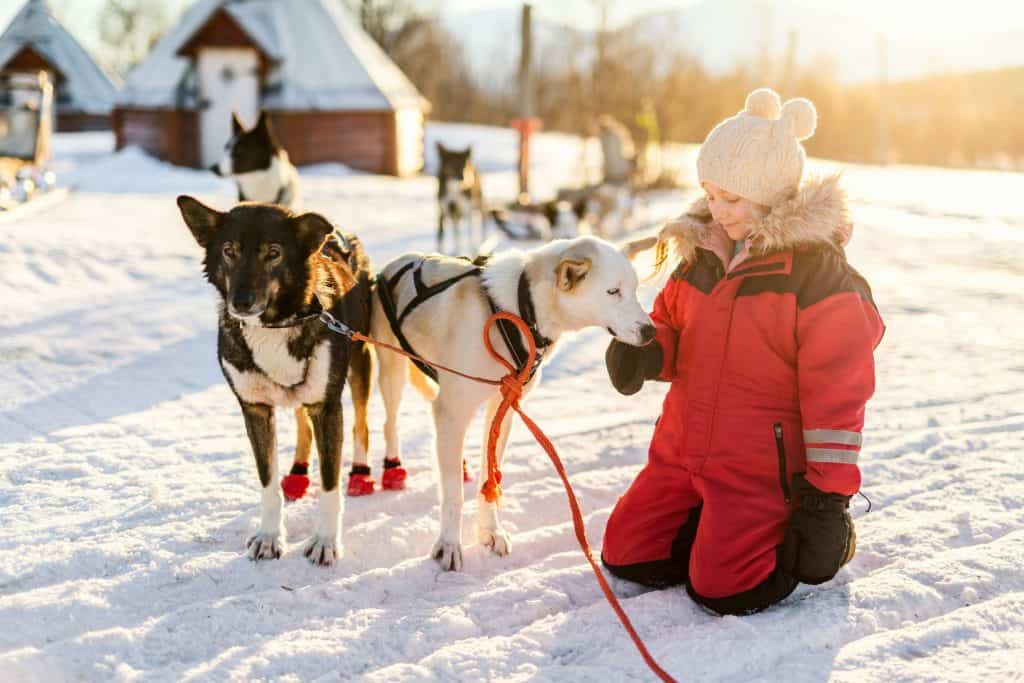
Mush!! If dog sledding is on your list of things to do this winter, I suggest that you prepare as much as possible. This preparation includes figuring out what to wear.
When dog sledding, wear multiple layers of waterproof, windproof, and insulating bottoms and tops. In addition to that, wear winter boots (such as Mukluks), multiple socks (preferably wool), heavy-duty gloves, an insulating hat, a face warmer, and sunglasses or ski goggles.
Having the right gear and dressing properly is essential to dog sledding and can even mean life or death. This is especially true when dog sledding in arctic conditions!
What to Wear While Dog Sledding
Base Layer/Underwear
- Long Johns (both tops and bottoms)
- Quick-drying/moisture-wicking material
- Wool, silk, synthetic, or polypropylene fabric
- Tight-fitting
Interior Layer
- Insulative sweaters
- Insulative pants
- Must be warm
- Wool, fleece, polypropylene, and synthetic fabrics
- Must also be breathable and non-restrictive
Mid Layers
- Insulative, waterproof, and windproof
- Can be doubled up
- Coats/Jackets, wind shells
- Fleece, Gore-Tex, or synthetic material
Outer Layers
- Durables, waterproof, and windproof
- Parkas and heavy-duty winter jackets with “fur ruff” hood
- Heavy-duty snow pants and bibs
- Gore-tex or synthetic material
Feet
- Double up on socks
- Synthetic and wool fabric
- Boots (-60 degree rating)
- Mukluks
- Waterproof overshoes
Hands
- Oversized fur mittens
- Fleece or synthetic base-gloves
Head and Face
- Wear an insulative hat (fleece, wool, synthetic, etc.)
- Balaclava or neoprene faceguard with a fleece interior
- Sunglasses, ski goggles, and protective eyewear
Base Layer/Underwear to Wear Dog Sledding
You should never underestimate the importance of the base layer! This is will be the layer that is closest to your skin.
It is extremely important to wear fabrics that insulate you from the cold and also wick away perspiration. The key to staying warm while dog sledding is staying dry. For this reason, you will want to stay away from fabrics that soak up moisture, such as cotton.
The base layer can consist of long underwear/long-johns that are tight-fitting to the skin. The best type of fabric to use for the base layer is silk, wool, or a synthetic fabric such as polypropylene fabric. It is imperative that you get a fabric that will draw the moisture away from your body. You will be sweating a lot while you are dog sledding and nothing is worse than wearing clothes than soak up the sweat.
Interior Layer
This interior layer is all about warmth and insulation. This layer should keep your body temp up while also allowing you to freely move. Therefore, I suggest buying things for this layer that aren’t too thick and restrictive.
For this layer, you may want to wear a sweater or pullover made out of wool, fleece, polypropylene, or other synthetic materials. Just be aware that shirts made out of synthetic materials tend to smell weird after a day of wearing them.
Honestly, you can’t go wrong with wool. Not only is warm, but it is also very water-resistant. Once again, stay away from cotton-based materials.
As far as pants are concerned, this you can find some warm and insulative fleece, wool, or synthetic-based options. Once again, the key is to insulate and keep warm. Make sure that you don’t buy too thick of pants or you will not be comfortable. When dog sledding, you still want to be able to move freely and easily.
Mid Layer(s)
This mid-layer (or layers) main duty is to further insulate, while also providing a waterproof and windproof barrier. It may seem like overkill, but this layer can be doubled up to provide extra protection.
Word to the wise, never underestimate how cold it can get, especially if you are dog sledding in arctic conditions.
This mid-layer(s) consists of a down jacket or vest and may even include an extra fleece coat. A Gore-Tex coat/jacket is also a great choice. You will want to find something that is both breathable, but also windproof and waterproof.
Another great item to wear for this layer is a wind shell that is waterproof and breathable.
This will protect you from the frigid winds that you are likely to experience. It may also be necessary to find something that includes a hood (that is if your outer layer doesn’t already have one).
Outer Layer(s)
Just like the base layer, the outer layer is arguably the most important layer. This is the layer that is the most exposed to the outside environment and weather. It is essentially the barrier between you and the elements.
For this layer, you will want to invest in some professional-grade Parkas that are waterproof and windproof. Think climbing up Everest type gear. The goal of this layer is to act as a protective shell. Make sure this winter coat or parka comes with a hood.
Many dog sledders prefer to have what is called a “fur ruff” around the hood. A fur ruff is a fur lining that surrounds the outside of a hood. This is the stereotypical “Eskimo” type jacket that you see on cartoons and movies. Fur ruffs are very effective. Not only do they insulate around the face, but they also warm the air before it reaches your face.
As far as pants go for this layer, you will want to find some heavy-duty snow pants (preferably bibs) that are windproof, waterproof, and insulative. Just like the jacket, the pants act as a barrier from the snowy conditions.

Feet
Your feet are one of the first things to get uncomfortable cold while dog sledding. This is why it is so imperative to buy the proper footgear to ensure that you are warm and cozy.
Socks
Trust me on this one, you will want to double up on socks. Although it sounds uncomfortable now, you will thank me later.
To start off with, you will want to have some tight-fitting synthetic socks as the base sock. These socks will wick away any sweat or moisture that is on your skin.
For the second layer of socks, you will want to find some thick wool socks. Winter weight wool or Smart Wool socks are the best options. Be sure to bring multiple pairs of socks with you, in case the ones you are wearing get wet.
Boots
You will want some heavy-duty boots, especially if you are going to be driving the sled.
Mushers tend to have to stomp on the breaks and walk through the snow quite a bit. You will want to find shin-high boots that have a temperature rating of -60 degrees and below. Many dog sledders will use a type of boot called Mukluks and often cover them with waterproof overshoes. This guarantees that your feet will stay dry and warm.
Hands
Most mushers wear oversized mittens, such as natural beaver fur mittens. Underneath these fur mittens are glove liners or another set of gloves. For the glove liners, I recommend a medium-weight fleece windproof glove. These will allow you to perform tasks and activities that call for the dexterity of your hands and also keep you warm.
If you are looking for a warmer base-glove, use something heavier, such as down or synthetic gloves.
Head and Face
Hat
You will want a hat that insulates the whole head, including the ears. Even though you will most likely employ the use of a hood and fur ruff, a hat is still absolutely necessary. Once again, use a hat that is made out of insulative material that wicks away moisture (fleece, wool, synthetic, etc.).
Make sure your hat fits well enough that it won’t come flying off.
Face Warmer
Many people buy a balaclava or neoprene faceguard that is usually fleece lined to protect their face from the cold. This especially comes in handy if it is windy or blizzarding outside.
Eye Wear
Lots of mushers wear sunglasses or ski goggles to protect their eyes from the sun and the cold. Snow blindness is a common occurrence amongst those who don’t wear proper eye protection.

Do’s and Dont’s of What to Wear Dog Sledding
Do Wear:
- Wool
- Fleece
- Silk
- Down
- Polypropylene
- Gore-Tex
Don’t Wear:
- Cotton (Cotton absorbs moisture and doesn’t dry. I can’t stress enough how important it is to not wear cotton.)
- A lot of tight layers
- Tennis shoes or skate shoes (basically anything other than boots)
- Jeans
- Sweats
- Dress Pants
- Leggings
- T-shirts
